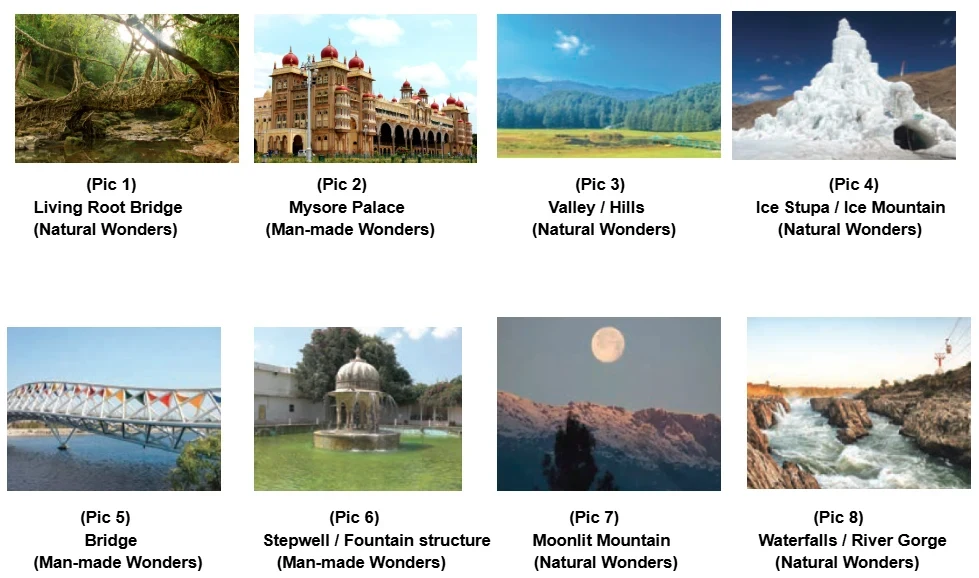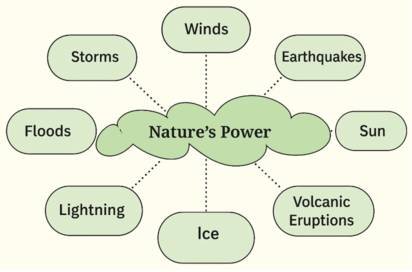This guide completes Spectacular Wonders Questions Answers Class 8 NCERT English – POORVI, Unit III, Chapter 3. The solutions cover comprehension questions, grammar exercises, and writing activities to make the lesson easier to understand. All answers are explained in clear and simple language, making it helpful for quick learning, revision, and exam preparation.
Let us do these activities before we read. (Page 137)
I Look at the pictures given below and sort them into natural and man-made wonders.
Ans:

II Which of these wonders—man-made or natural—are more appealing and why? Share your answers with your classmates and teacher.
Ans:
I find natural wonders more appealing than man-made ones. Natural wonders like mountains, rivers, waterfalls, and valleys show the true beauty and power of nature. They are not created by people but formed over millions of years, which makes them unique and special. When we look at them, we feel peace, joy, and a strong connection with the Earth. Man-made wonders are also beautiful and show human skill, but they cannot match the freshness and purity of natural creations. Natural wonders remind us to protect our environment and appreciate the world we live in. That is why I prefer them.
POORVI: Textbook of English for Grade 8 NCERT Solution 2025-2026:
III Work in pairs. Write down two wonders of nature that have amazed you. Discuss what makes them impressive. Share your answers with your classmates and teacher.
Ans:
| Wonder of Nature | What makes it impressive? |
| Niagara Falls | Its powerful waterfalls create a thunderous sound and breathtaking view. The huge volume of water flowing every second amazes me. |
| The Himalayas | The tallest mountain range in the world. Its snow-covered peaks, beauty, and spiritual importance make it very special. |
IV Work in groups of four. Complete the web chart given below with words that you associate with the phrase, ‘Nature’s Power’. Share your answers with your classmates and teacher.
Ans:

1. THE VALLEY OF FLOWERS, UTTARAKHAND
Summary:
The Valley of Flowers in Uttarakhand is a UNESCO World Heritage Site, famous for its breathtaking beauty and rich biodiversity. Spread across Chamoli district, it blooms between May and October, turning into a botanical paradise. With nearly 600 species of flowers like orchids, poppies, marigolds, and daisies, it offers a colourful landscape against the mighty Himalayas. The trek to the valley reveals waterfalls, streams, and rare wildlife, including snow leopards, red foxes, and flying squirrels. Its unmatched scenic charm and stunning backdrop attract nature lovers and adventurers, making it one of India’s most enchanting natural wonders.
Word Notes:
- Spectacle: sight : दृश्य
- Exotic: unusual : असाधारण
- Bloom: blossom : खिलना
- Glory: magnificence : महिमा
- Spectacular: wonderful : शानदार
- Rare: uncommon : दुर्लभ
- Wildlife: animals : वन्यजीव
- Backdrop: background : पृष्ठभूमि
- Stunning: amazing : चौंकानेवाला
- Experience: adventure : अनुभव
- Spread: extend : फैलना
- Wonderland: magical land : जादुई जगह
2. THE LIVING ROOT BRIDGES, MEGHALAYA
Summary:
The Living Root Bridges of Meghalaya are unique creations built by intertwining roots of rubber fig trees. These bridges, made by indigenous people, replace temporary bamboo or wooden bridges that were destroyed during monsoons. They are not only an engineering marvel but also a cultural heritage symbolising harmony with nature. Some bridges last hundreds of years, stretch 50 to 100 feet high, and the longest is 175 feet. With around 100 such bridges spread across villages, they represent innovation, tradition, and sustainable living. Today, these root bridges are considered among the most fascinating UNESCO heritage wonders.
Word Notes:
- Indigenous: native : स्वदेशी
- Incredible: amazing : अविश्वसनीय
- Tangible: real : वास्तविक
- Heritage: tradition : धरोहर
- Waterways: channels : जलमार्ग
- Futile: useless : व्यर्थ
- Innovative: creative : नवाचारी
- Intertwined: twisted : गुँथा हुआ
- Symbolises: represents : प्रतीक करना
- Cultural: traditional : सांस्कृतिक
- Persist: survive : बने रहना
- Whopping: huge : विशाल
3. THE LONAR CRATER LAKE, MAHARASHTRA
Summary:
The Lonar Crater Lake in Maharashtra is a geological marvel created thousands of years ago by a meteorite impact. It is the only crater in India formed on basaltic rock and ranks among the world’s largest craters. The lake inside its circular depression is saline and creates a striking contrast with the rugged surroundings. Known for its ancient origins, it highlights the fusion of celestial forces with Earth’s natural beauty. The crater’s rim offers breathtaking views of nature’s power. Lonar Lake stands as both a scientific wonder and a captivating tourist attraction reflecting Earth’s mysterious past.
Word Notes:
- Geological: earth-science : भूवैज्ञानिक
- Wonder: marvel : चमत्कार
- Colossal: gigantic : विशाल
- Blazing: burning : जलता हुआ
- Impact: collision : टक्कर
- Basaltic: volcanic-rock : बेसाल्ट चट्टान
- Meteorite: space-rock : उल्का पिंड
- Crater: hollow : गड्ढा
- Depression: low area : अवसाद
- Saline: salty : खारा
- Extraordinary: remarkable : असाधारण
- Allure: charm : आकर्षण
4. MAGNETIC HILLS IN LEH DISTRICT, LADAKH
Summary:
Magnetic Hill in Ladakh is a mysterious natural phenomenon located 30 km from Leh. Known as the “Hill that defies gravity,” it creates an optical illusion that makes vehicles appear to move uphill at 20 km/h when parked at a specific spot. The unusual effect results from the alignment of slopes and the horizon. Marked by a signboard, it has fascinated tourists for years, leaving many in disbelief. The hill is one of Ladakh’s most visited attractions, blending scientific curiosity with mystique. Its striking visual trick makes Magnetic Hill an unforgettable part of Himalayan adventures.
Word Notes:
- Fascinating: interesting : आकर्षक
- Gravity: force : गुरुत्वाकर्षण
- Distance: length : दूरी
- Phenomenon: occurrence : घटना
- Defies: resists : चुनौती देता है
- Visitors: tourists : आगंतुक
- Indicated: marked : चिह्नित
- Illusion: false vision : मृगतृष्णा
- Peculiar: unusual : अजीब
- Alignment: arrangement : संरेखण
- Surrounding: nearby : आसपास
- Disbelief: doubt : अविश्वास
5. GLOWING WATERS OF KERALA
Summary:
In Kumbalangi, a serene village near Kochi, Kerala, one can witness the enchanting phenomenon of glowing waters at night. Caused by bioluminescence, this effect is due to micro-planktons that emit light in the water. It creates a magical spectacle in the backwaters, attracting tourists and nature lovers. Kumbalangi is also promoted as an eco-tourism village, where visitors enjoy not only the glowing waters but also the beauty of village life, local cuisine, and cultural traditions. This natural wonder showcases the blend of science and beauty, making Kumbalangi a unique and eco-friendly tourist destination.
Word Notes:
- Serene: peaceful : शांत
- Backwaters: lagoons : बैकवाटर/झीलें
- Magically: wonderfully : जादुई रूप से
- Phenomenon: occurrence : घटना
- Bioluminescence: natural light : जैवदीप्ति
- Concentration: density : घनत्व
- Organisms: creatures : जीव
- Captured: attracted : आकर्षित किया
- Attention: focus : ध्यान
- Eco-tourism: nature-tourism : पारिस्थितिक पर्यटन
- Acquaint: familiarise : परिचित कराना
- Simplicity: plainness : सादगी
6. THE SUNDARBANS
Summary:
The Sundarbans in West Bengal is the world’s largest mangrove forest, covering 1,400 sq km in the Ganga-Brahmaputra-Meghna delta. Known for its Sundari trees, it thrives in coastal zones where roots grow under water in oxygen-poor soil. These roots slow down tides, stabilising the coastline and preventing erosion. The forest shelters diverse flora and fauna, including rare species like estuarine crocodiles, Indian pythons, and the famous Bengal tiger. Rich in biodiversity, the Sundarbans is both an ecological treasure and a protective natural barrier for coastal life. It represents the harmony between land, water, and wildlife.
Word Notes:
- Coastal: seaside : तटीय
- Mangrove: swamp-forest : मैंग्रोव
- Oxygen: air-element : ऑक्सीजन
- Stabilising: balancing : स्थिर करना
- Erosion: wearing-away : कटाव
- Delta: river-mouth : डेल्टा
- Derived: taken-from : व्युत्पन्न
- Plentiful: abundant : प्रचुर
- Extensive: wide : विस्तृत
- Majestic: grand : भव्य
- Threatened: endangered : संकटग्रस्त
- Fauna: animal-life : जीव-जंतु
7. THE INVISIBLE CHANDIPUR BEACH, ODISHA
Summary:
Chandipur Beach in Odisha is known as the “invisible beach” because the sea mysteriously disappears and reappears daily. During ebb tide, the water retreats by 2–5 km, exposing the seabed, and returns with the high tide. This rare natural phenomenon makes the beach appear as though it is playing hide-and-seek with visitors. Located in Balasore district, it attracts tourists eager to witness this unusual event. Chandipur’s disappearing sea highlights the unique behaviour of tides and remains one of India’s most fascinating coastal wonders, combining science with a magical visual experience.
Word Notes:
- Disappearing: vanishing : गायब होना
- Mysteriously: strangely : रहस्यमय ढंग से
- Unique: special : अनोखा
- Feature: characteristic : विशेषता
- Visitors: tourists : आगंतुक
- Retreats: withdraws : पीछे हटना
- Ebb tide: low-tide : भाटा
- High tide: rising tide : ज्वार
- Unusual: uncommon : असामान्य
- Phenomenon: occurrence : घटना
- Witness: observe : गवाह होना
- Awe-inspiring: breathtaking : विस्मयकारी
Let us discuss (Page 142)
I Complete the information in the table given below. One example has been done for you. Share your answers with your classmates and teacher.
Ans:
| Amazing Natural Phenomena | Location | One Unique Feature |
| 1. The Valley of Flowers | Chamoli district, Uttarakhand | Around 600 species of exotic flowers |
| 2. The Living Root Bridges | Meghalaya | Incredible bridges made of intertwined living roots |
| 3. The Lonar Crater Lake | Buldhana district, Maharashtra | Formed by a meteorite impact; only crater in India in basaltic rock |
| 4. Magnetic Hills | Leh district, Ladakh | Vehicles appear to roll uphill due to optical illusion |
| 5. Glowing Waters | Kumbalangi village, Kerala | Waters glow at night due to bioluminescence caused by micro-planktons |
| 6. The Sundarbans | West Bengal | World’s largest mangrove forest; home to Bengal tiger and other species |
| 7. The Invisible Chandipur Beach | Balasore district, Odisha | Sea disappears and reappears daily due to ebb and high tide |
Let us think and reflect (Page 142)
I Read the given extracts and answer the questions that follow.
1. India is home to some of the most mystifying natural phenomena that surprise and spark our imagination
(i) Replace the underlined phrase with one from the extract.
India is the birthplace of several rare species of flora and fauna that thrive in its diverse ecosystems.
(ii) What does the phrase ‘nature’s unusual side’ suggest about the phenomena described?
(iii) Complete the similarity by choosing the correct option.
spark: imagination : : ______________ : ______________.
A. inspiration; creativity
B. wonder; amazement
C. effort; reward
D. knowledge; books
(iv) Identify whether the following statement is true or false.
Some natural phenomena can surprise people.
Ans:
(i) “India is home to some of the most mystifying natural phenomena.”
(ii) It suggests that the phenomena are rare, surprising, and extraordinary aspects of nature that we do not normally see.
(iii) option: A. inspiration : creativity
(Reason: Just as a spark sets off imagination, inspiration sets off creativity.)
(iv) ✔ True (Text: “that surprise and spark our imagination”)
2. Have you seen things disappearing in front of your eyes? Well, such things happen at times, when we keep things at some place, and just forget where we have kept them. But, what if there’s a sea that disappears? This happens in Odisha. It is a beach in the Balasore district where one can witness the sea disappearing mysteriously—the Chandipur Beach which is known for its unique feature of playing hide-and-seek with its visitors.
(i) Complete the following sentence with a suitable reason.
The writer’s most likely purpose to introduce the information about the Chandipur Beach phenomenon with a question is to ____________________. (engage the reader’s curiosity and create a sense of suspense/draw the reader to learn more about the unusual phenomenon/set the tone for the surprising nature of the content that follows)
(ii) Select the option that is correct for both Assertion (A) and Reason (R).
(A): Chandipur Beach in Odisha is known for its unique feature of the sea disappearing.
(R): The tides retreat drastically, exposing the Chandipur beach.
A. Both (A) and (R) are true, and (R) is the correct explanation of (A).
B. Both (A) and (R) are true, but (R) is not the correct explanation of (A).
C. (A) is true, but (R) is false.
D. (A) is false, but (R) is true.
(iii) What does the term ‘unique’ suggest about the beach in Balasore?
A. very popular
B. one of its kind
C. ancient place
D. far from city
(iv) What does the writer want to convey with the use of the phrase ‘playing hide-and-seek with its visitors’?
Ans:
(i) engage the reader’s curiosity and create a sense of suspense.
(ii) A. Both (A) and (R) are true, and (R) is the correct explanation of (A). (Text: “The sea water moves. It retreats by 2–5 km during ebb tide, and comes back at the time of high tide.”)
(iii) B. one of its kind (Text: “the Chandipur Beach which is known for its unique feature of playing hide-and-seek with its visitors”)
(iv) It means the sea water disappears and reappears daily, retreating during ebb tide and returning during high tide.
II Answer the following questions.
1. How are the living root bridges a boon for the local people of Meghalaya?
Ans: The living root bridges are a boon for the local people of Meghalaya because they provide a strong and lasting way to cross waterways during heavy rains and monsoons. Bamboo or wooden bridges could not survive the strong waters, but root bridges are durable and last for centuries. They also symbolise the local people’s knowledge of their land and serve as a natural ecosystem of flora.
2. Why is the Lonar Crater Lake considered a remarkable and rare site?
Ans: The Lonar Crater Lake is remarkable and rare because it was formed thousands of years ago when a colossal meteorite crashed into the Earth. It is the only crater in India formed in basaltic rock by a meteorite impact. Globally, it is among the top five largest craters. Its circular depression holds a saline lake, creating a striking view that blends celestial impact with terrestrial beauty.
3. What might be the writer’s purpose of highlighting the awe-inspiring natural wonders of India?
Ans: The writer’s purpose is to show how India’s landscapes are full of mystique and charm through unusual natural wonders. These examples reveal nature’s artistic flair and extraordinary forces that shape our environment. They also remind us of the scientific intrigue and folklore connected to them. By describing these wonders, the writer seeks to surprise, inspire, and capture the readers’ imagination about India’s unique natural heritage.
4. The writer uses descriptive language and introductory questions for some of the natural phenomena. What impact does it have on the readers?
Ans: The use of descriptive language and questions creates curiosity and suspense in the readers’ minds. For example, asking about disappearing seas or building bridges without cement makes readers wonder how it is possible. This style draws attention to the unusual features of nature and keeps the readers engaged. It also helps them visualise the phenomena clearly, making the information memorable and interesting to explore further.
5. Which of these unusual phenomena did you find the most interesting and why?
Ans: The most interesting phenomenon is the Invisible Chandipur Beach in Odisha. It is fascinating because the sea disappears and reappears daily, moving back by 2–5 km during ebb tide and returning during high tide. This rare hide-and-seek game of the sea is both mysterious and exciting to imagine. It is a natural phenomenon that surprises visitors and shows the unusual yet captivating side of nature.
Let us learn (Page 144)
I Fill in the blanks with the correct expressions from the text given in the box below.
| came into existence to no end in full glory in disbelief to name a few age-old problem |
Ans:
1. I have read many stories to no end.
2. Do you know when this little town came into existence?
3. His hard work has helped him to name a few.
4. There are no simple solutions to the age-old problem of traffic jams.
5. He opened the ancient wooden box and stared at the treasure in disbelief.
6. The garden is in full glory in spring with lots of beautiful flowers in bloom.
II Select the correct synonyms from the box given below that match the list of words in 1–5. You may refer to a thesaurus.
| colossal exotic serene enigmatic spectacular |
Ans:
1. mysterious, puzzling, baffling → enigmatic
2. mighty, gigantic, huge → colossal
3. breath-taking, stunning, awe-inspiring → spectacular
4. peaceful, calm, tranquil → serene
5. unusual, peculiar, foreign → exotic
III The expressions ‘hide-and-seek’ and ‘flora and fauna’ are used in the text. These are called binomials—a pair of fixed words joined by ‘and’ or ‘or’. The binomials are mostly synonyms, antonyms, rhyming words, same sound words (alliterations), etc.
Match the binomials in Column 1 with their meanings in Column 2. You may refer to a dictionary.
Ans:
| Column 1 (Phrase) | Column 2 (Meaning) |
| 1. odds and ends | (vii) small, unimportant things |
| 2. on and off | (v) sometimes, occasionally |
| 3. mix and match | (i) put different things together to get a range of possibilities |
| 4. all or nothing | (viii) something to be done completely or not at all |
| 5. part and parcel | (ii) complete part of or belong to |
| 6. pick and choose | (iii) choose only the best (things, people, etc.) |
| 7. sooner or later | (iv) at some time in the future |
| 8. leaps and bounds | (vi) increase or develop very quickly |
Use the binomials given in Column 1 in sentences of your own.
Ans:
1. I found a few odds and ends in the old drawer.
2. The internet connection works on and off during the rains.
3. You can mix and match shirts and trousers to create new styles.
4. His success plan was all or nothing, with no halfway effort.
5. Hard work is a part and parcel of achieving success.
6. She likes to pick and choose only the ripest fruits from the market.
7. Sooner or later, the truth will be revealed.
8. The company has grown by leaps and bounds in recent years.
IV Study the highlighted words in the following sentences from the text.
• The living root bridges are one of Meghalaya’s most beautiful…
• …creating a striking visual contrast against the surrounding rugged terrain.
In the given sentences, the highlighted words ‘living’, ‘striking’, and ‘rugged’ are examples of verbs used as adjectives. Such verbs are called participles.
Now, fill in the blanks using present participle or past participle form of the verbs in the box given below.
| stand amaze carve scatter glow |
Ans:
1. The glowing marble monument looks even more spectacular in the moonlight. (present participle)
2. The amazing view of the Himalayas from Darjeeling attracts visitors from all over the world. (present participle)
3. The Sun Temple in Konark features intricately carved stone wheels and walls. (past participle)
4. Standing at a height of 182 m, the Statue of Unity is dedicated to Sardar Vallabhbhai Patel (present participle)
5. The scattered islands of the Andaman and Nicobar offer some of the cleanest beaches in India. (past participle).
V Study the highlighted word in the following sentence from the text.
Underline the gerunds and participles in the following sentences. Write ‘G’ for gerunds and ‘P’ for participles in the space provided. One example has been done for you.
Ans:
1. Dancing is a great way to express emotions. G (already given)
2. Travelling (G) can broaden your perspective.
3. The falling (P) leaves signalled the arrival of autumn.
4. She enjoys cooking (G) new recipes for her family.
5. Reading (G) helps improve your vocabulary.
6. He watched the shimmering (P) stars in the night sky.
7. Forgetting (P) the keys inside, Kanchan locked the door.
[Gerunds act like nouns, while participles act like adjectives or describe actions.]
VI Combine the following pairs of sentences using participles or gerunds. You may use the clues given in brackets. One example has been done for you.
Ans:
1. Entering the room, Nitesh saw his friend sitting in the corner. (participle)
2. Walking carelessly, Smitha slipped on the doormat. (participle)
3. Sleeping for eight hours is good for health. (gerund)
4. Feeling happy about the result, Ranjith called his parents. (participle)
5. Father encouraged Meena to join the course. (gerund)
Let us listen (Page 148)
I You will listen to a brother and sister discuss a natural phenomenon. As you listen, mark the four true statements from 1–6 given below. (Transcript for teacher on page 153)
Ans:
1. The brother was taken aback to see the posted pictures. False
(Supporting Statement: He liked them but was not shocked.)
2. The brother admitted to not knowing about his sister’s favourite picture. True
(Supporting Statement: He says: “Really! I didn’t know it was your favourite too.”)
3. The sister stated that the rainbow mountain was like any other mountain. False
(Supporting Statement: She said it was her favourite and looked like nature painted it.)
4. The brother was aware of the reason for the formation of colours on the mountain. True
(Supporting Statement: He explained it’s due to minerals like clay, limestone, and sandstone.)
5. The brother was surprised to learn about the mountain being covered with snow till recently. True
(Supporting Statement: He said: “I cannot believe the fact that it was all buried under snow until recently.”)
6. The sister understood nature’s role in the beauty of the mountain. True
(Supporting Statement: She said: “It’s like nature painted the mountain!”)
Let us speak (Page 149)
I Work in groups of four. Make a presentation on a place of interest in and around your region that people like to visit. You may use the following guidelines to make your presentation.
Guidelines:
1. Slides 1–2: Choose any popular place of interest in your region.
2. Slides 3–4: Mention where it is located and how to reach there.
3. Slides 5–6: Describe the attractions of the place, why it is popular and explain its historical importance, if any.
4. Slides 7–8: List out weather conditions, local food, customs, and language.
5. Slides 9–10: Suggest the best time of the year to visit and why you recommend this place.
Ans:
Here’s a ready sample presentation draft you can use and expand into slides for the “Let us Speak” activity. I’ll make it on Darjeeling (West Bengal) as an example. You can replace it with any place of interest in your region.
Slide 1–2: Popular Place of Interest
Title: Darjeeling – The Queen of Hills
- Darjeeling is one of the most famous hill stations in India.
- Known for its tea gardens, toy train, and breathtaking view of the Kanchenjunga.
Slide 3–4: Location & How to Reach
- Location: Northern West Bengal, in the Lesser Himalayas.
- How to Reach:
- Nearest airport – Bagdogra (70 km).
- Nearest railway station – New Jalpaiguri (NJP).
- From Siliguri, people travel by car, bus, or the famous toy train.
Slide 5–6: Attractions & Popularity
- The Darjeeling Himalayan Railway (UNESCO World Heritage Site).
- Tiger Hill – sunrise view over Mt. Kanchenjunga.
- Padmaja Naidu Zoological Park & Himalayan Mountaineering Institute.
- Peace Pagoda and tea estates.
- Famous for “Darjeeling Tea” – world-famous flavor.
Slide 7–8: Weather, Food, Customs & Language
- Weather: Pleasant in summer; cold in winter. Snowfall in higher areas.
- Food: Momos, thukpa, traditional Nepali dishes, and Darjeeling tea.
- Customs & Culture: Mix of Nepali, Tibetan, Lepcha, and Bengali traditions.
- Language: Nepali is widely spoken, along with Bengali, Hindi, and English.
Slide 9–10: Best Time to Visit & Recommendation
- Best Time: March–May (spring) and October–December (autumn/winter).
- Why Visit?
- Cool climate, scenic beauty, and rich culture.
- Perfect getaway for nature lovers and adventure seekers.
- Unique experience of Himalayan heritage and tea culture.
Make this into a PowerPoint (PPT) file for you with simple designs and text.
Let us write (Page 149)
I You just read vivid descriptions of the natural wonders of our country. Write a descriptive essay for your school magazine describing anything from nature that attracted your attention. It may be an object, a place, or an event experienced by you. Remember to give a title to your essay. Use proper format and content organisation—begin with a title, include introduction (one paragraph), body (two to three paragraphs), and conclusion (one paragraph).
Ans:
The Majestic Sunset by the River
Introduction
One of the most beautiful sights I have ever experienced in nature is the sunset by the river near my hometown. It is a daily wonder, yet every evening it feels new and enchanting. The calmness of the river, the changing colours of the sky, and the soothing breeze create a scene that stays in my memory forever.
Body
As the sun begins to sink behind the distant trees, the sky turns into a canvas of colours—golden yellow, fiery orange, and shades of pink and purple. The soft ripples of the river catch the glow of the sun, reflecting it like a giant mirror. Birds fly back to their nests, their silhouettes adding charm to the view.
The cool breeze brushes against my face while the sound of the flowing water makes the whole scene peaceful. Sometimes, fishermen in their small boats add life to the view, moving slowly across the shining surface. The fragrance of wet soil and the gentle rustling of leaves complete the magical atmosphere.
Conclusion
The sunset by the river teaches me to pause and appreciate the beauty of nature. It fills my heart with peace and reminds me that simple moments can bring the greatest joy. For me, this sight is not just an evening view—it is a lesson in patience, calmness, and the wonders of the natural world.
Let us explore (Page 150)
I Man-made Wonders
Ans: Read the textbook
II Some micro-planktons in the sea are bioluminescent. Have you seen any other life form that has this quality? Identify the insect given below and find out what it is called in your language. Look out for it when you visit a field or a place with a wetland.
Ans: Do it yourself







